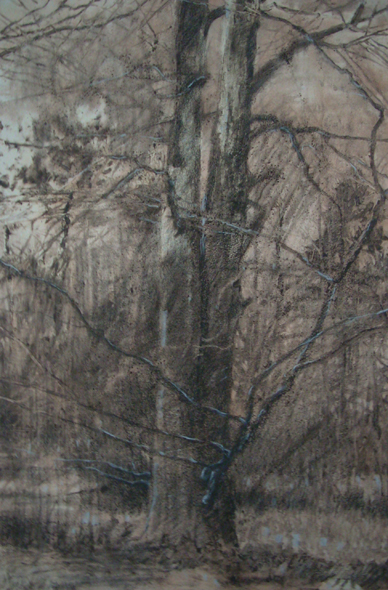I am pleased to share that this print has been accepted into the Twenty-Third Minnestrista Annual Jurried Art Show (2013), in Muncie, Indiana.
It is curious that one of the more important things I needed to teach my students was that sometimes if there is an unexpected result, a misjudgement, or outright error that often with careful planning and execution of skills and technique corrections can be made. On the other hand sometimes the work goes in an unintended direction and no amount of work will salvage the piece, in essence it is “burnt toast” and no amount of butter and jam will make it look or taste good. It is important to discern when there is a chance of salvaging a work or when it is time to start over.
With the above in mind, it is interesting to me how often the path that I intend to take is often not as straight or direct as I assumed or desired, and as a result that when this involves making art the unexpected problem or annoying challenge sometimes proves to be a benefit, a positive learning opportunity, perhaps a fine solution or even a more desired improved/unexpectedly pleasing end result. Serendipity. In these circumstances, I wish I could claim, “Yeah, that’s what I planned all along,” wherein the truth is closer to the fact that I had the presence of mind during a minor crisis or meltdown to recognize “Wow, that is NICE!!” and then quit while I am ahead and before I ruin the thing. This print is such an example, and from it I learned methods I can use to selectively mute applied color and diffuse parts of the monotype print while working at the press. This frankly wasn’t what I started out intending to do with this piece, but I must admit that what I learned in getting to the end result proved to be a nice return for my investment of time and labor.
This main subject is the same beech tree at Pendle Hill (Wallingford, PA) that I have done other monotype printings of, but the difference here is that I have reversed the image when painting it on the printing plate, using Burnt Siena and Ivory Black oil paints, with clove oil to retard the drying time of the pigments.
In my desire to get the drawing, tones, and details where I wanted them I had unwittingly taken too long painting the image by re-working and making adjustments on the plate (using brushes, corners of rags, Q-tips, pieces of mat board, cheese cloth, etc.). In my effort to control the image as I had envisioned it, by being overly critical (and fussy), the pigments had stiffened in some areas on the plate.
When I ran this plate and the paper through the etching press and pulled back a corner of the printed image I was disappointed because the image was weaker than I had wanted – for all my care, the pigments had become stiff in some parts and did not transfer well to the paper. I didn’t want to lose out on the time and effort I had already put into the work and as such misted the back of the print paper with odorless mineral spirits, and ran it back through the press. This improved the print result from before, but not enough. Putting on a filter mask and rubber gloves, I re-misted the print paper and reworked it printing it by hand-rubbing using a baren (in this case a wooden spoon – Poplar wood), for this reason you can see marks left in the image as a result of this process. I had succeeded in rescuing the image, and in the process had added a softer quality to the print. Some areas had lost intended definition, but by this point the work was so far removed from what I had initially intended that I felt I might as well go a step further and work into the image some more, experimenting with charcoal and conte sticks.
